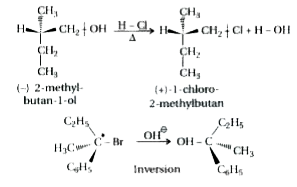Text Solution
Verified by Experts
|
Topper's Solved these Questions
HALOALKANES AND HALOARENES
KUMAR PRAKASHAN|Exercise SECTION - B INTEXT QUESTIONS AND ANSWERS|20 VideosView PlaylistHALOALKANES AND HALOARENES
KUMAR PRAKASHAN|Exercise SECTION - C TEXTUAL EXERCISE|87 VideosView PlaylistHALOALKANES AND HALOARENES
KUMAR PRAKASHAN|Exercise SECTION - E Multiple Choice Questions|260 VideosView PlaylistGENERAL PRINCIPLES AND PROCESSES OF ISOLATION OF ELEMENTS
KUMAR PRAKASHAN|Exercise SECTION - E (MCQs ASKED IN GUJET/BOARD EXAMS)|46 VideosView PlaylistPOLYMERS
KUMAR PRAKASHAN|Exercise SECTION - E (MCQs asked in Board Exams)|51 VideosView Playlist
Similar Questions
Explore conceptually related problems
Knowledge Check
A
B
C
D
Submit
Similar Questions
Explore conceptually related problems
KUMAR PRAKASHAN-HALOALKANES AND HALOARENES-SECTION - A QUESTIONS
- Explain the factors affecting S(N)1 reaction.
04:31
|
Play - Enlist the main points of difference between S(N)1 and S(N)2 reactions...
03:33
|
Play - What is retention and inversion of configuration ? Explain with suitab...
05:24
|
Playing Now - Explain stereochemistry of S(N)1 reaction with suitable example.
06:20
|
Play - Explain stereochemistry of S(N)2 reaction with suitable example.
04:15
|
Play - Explain Elimination reactions of alkyl halides.
05:28
|
Play - Explain dehydrohalogenation (beta - elimination) of alkyl halides.
03:50
|
Play - Explain how sustitution and elimination reactions compete in the same ...
05:22
|
Play - Write a note on Grignard Reagent.
04:18
|
Play - Write a note on Wurtz Reaction.
04:30
|
Play - Explain why aryl halides are extermely less reactive towards nucleophi...
06:09
|
Play - Give the reaction of hydroxyl group with chlorobenzene.
03:49
|
Play - Explain why the electron withdrawing groups such as -NO(2) show its ef...
07:52
|
Play - Why aryl halides undergo electrophilic substitution reactions at o - a...
04:11
|
Play - Give following reaction of aryl halides : (i) Halogenation (ii...
05:18
|
Play - Give reactions of aryl halides with metals.
04:17
|
Play - State the various uses of : Dichloromethane (Methylene chloride)
02:28
|
Play - State the various uses of : Trichloromethone (Chloroform)
02:05
|
Play - State the various uses of : Tri - iodomethane (Iodoform)
02:08
|
Play - State the various uses of : Tetrachloromethane (Carbon tetrachlorid...
02:27
|
Play
